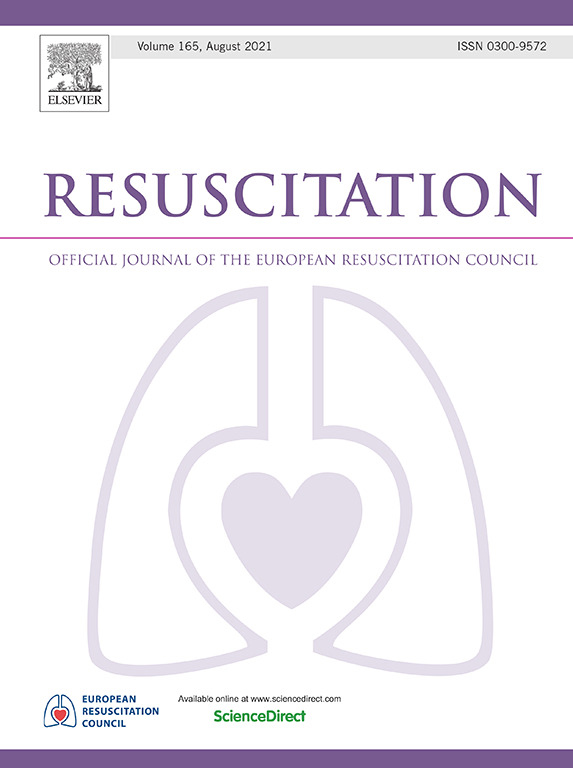Comparison of ventilation modes in non-traumatic out-of-hospital cardiac arrest: SYMEVECA phase 2
IF 6.5
1区 医学
Q1 CRITICAL CARE MEDICINE
引用次数: 0
Abstract
Aim
To compare clinical outcomes associated with different ventilation approaches during cardiac arrest.
Methods
Pragmatic prospective quasi-experimental study in non-traumatic out-of-hospital cardiac arrest in adults attended by an emergency medical service between April-2021 and September-2024. Patients were classified in three groups according to the ventilation method during CPR: Chest Compression Synchronized Ventilation-CCSV (inspiratory time 205 ms), intermittent positive pressure ventilation-IPPV (tidal volume 7 ml/kg, rate 10–12 bpm) or manual resuscitator bag. Main outcome was survival at hospital discharge or 28 days with good neurological recovery (CPC 1–2). We also measured blood gas values 15 min after tracheal intubation or when spontaneous circulation was achieved.
Results
Of the 773 cardiac arrests recorded, 252 were excluded due to very early recovery (193), airway difficulty (54) or protocol violations (5). Patients were analyzed by groups: CCSV (100), IPPV (145) or resuscitator bag (276). In patients with a venous control sample, pH was 7.01 ± 0.15 in CCSV group, 7.00 ± 0.14 in IPPV and 6.96 ± 0.15 in the bag group (p = 0.02). The pCO2 was 76.9 ± 31.8, 78.3 ± 25.4 and 84.7 ± 30.1 mmHg, respectively (p = 0.13). A spontaneous circulation was achieved in 61% with CCSV, 57.2% with IPPV and 49.3% with bag (p = 0.08). Survival with good neurological outcome was 16% in CCSV group, 12.4% in IPPV and 9.4% with bag (p = 0.19; p = 0.07 between CCSV and bag groups).
Conclusion
Successful resuscitation may vary according to ventilation mode – the use of a mechanical ventilation and different modes such as CCSV requires further study.
非外伤性院外心脏骤停的通气方式比较:symevea 2期。
目的:比较心脏骤停时不同通气方式的临床结果。方法:对2021年4月至2024年9月期间急诊医疗服务的成人非创伤性院外心脏骤停进行实用前瞻性准实验研究。根据心肺复苏过程中的通气方式将患者分为三组:胸压同步通气- ccsv(吸气时间205 ms),间歇正压通气- ippv(潮气量7 ml/kg,速率10-12 bpm)或手动复苏袋。主要结局为出院时存活或28天神经功能恢复良好(CPC 1-2)。我们还测量了气管插管后15分钟或达到自然循环时的血气值。结果:在记录的773例心脏骤停中,252例因恢复非常早(193例)、气道困难(54例)或违反协议(5例)而被排除。对患者进行分组分析:CCSV (100), IPPV(145)或复苏袋(276)。静脉对照标本CCSV组pH为7.01±0.15,IPPV组pH为7.00±0.14,bag组pH为6.96±0.15 (p=0.02)。pCO2分别为76.9±31.8、78.3±25.4和84.7±30.1 mmHg (p=0.13)。CCSV组有61%,IPPV组有57.2%,bag组有49.3% (p=0.08)。CCSV组神经系统预后良好的生存率为16%,IPPV组为12.4%,bag组为9.4% (p=0.19;CCSV组与bag组之间p=0.07)。结论:不同的通气方式对复苏成功率有不同的影响,机械通气和CCSV等不同的通气方式需要进一步的研究。
本文章由计算机程序翻译,如有差异,请以英文原文为准。
求助全文
约1分钟内获得全文
求助全文
来源期刊

Resuscitation
医学-急救医学
CiteScore
12.00
自引率
18.50%
发文量
556
审稿时长
21 days
期刊介绍:
Resuscitation is a monthly international and interdisciplinary medical journal. The papers published deal with the aetiology, pathophysiology and prevention of cardiac arrest, resuscitation training, clinical resuscitation, and experimental resuscitation research, although papers relating to animal studies will be published only if they are of exceptional interest and related directly to clinical cardiopulmonary resuscitation. Papers relating to trauma are published occasionally but the majority of these concern traumatic cardiac arrest.
 求助内容:
求助内容: 应助结果提醒方式:
应助结果提醒方式:


